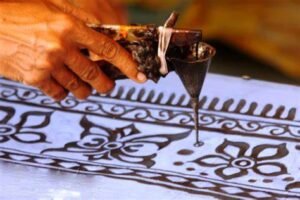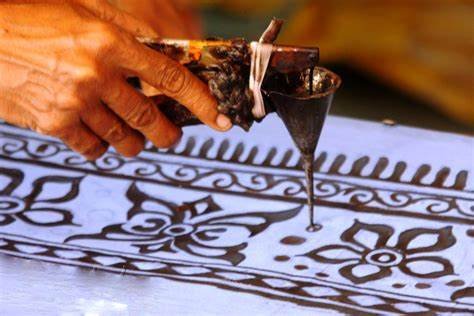
Batik factory in Sri Lanka
A Vibrant Tapestry of Culture and Craftsmanship BATIK FACTORY IN SRI LANKA What is Batik? Sri Lankan batik is a traditional textile art form renowned

Sri Lankan batik is a traditional textile art form renowned for its vibrant and intricate designs. It is a process of decorating fabric with colorful patterns using wax-resist dyeing techniques. Artisans create these patterns by applying hot wax to specific areas of the fabric, which prevents those areas from absorbing dye. After the wax application, the fabric is submerged in dye baths, and the waxed sections maintain their original color. This process can be repeated with different colors, allowing for the creation of complex and visually striking designs.
Sri Lankan batik often features motifs inspired by the island’s rich cultural heritage, including nature, folklore, and traditional symbols. The resulting textiles are used to make various products such as clothing, wall hangings, tablecloths, and decorative items. Sri Lankan batik is not only a form of artistic expression but also a significant cultural symbol that represents the country’s heritage and craftsmanship. It has gained recognition worldwide, making it an essential part of Sri Lanka’s cultural identity and a popular choice for both locals and tourists seeking beautiful and distinctive textiles.

Batik is a time-honored textile art form with a rich history that spans centuries and cultures. Its origins are somewhat elusive, as similar techniques have been independently developed in various parts of the world, including Indonesia, India, Africa, and Sri Lanka. However, it is most closely associated with Indonesia, particularly the island of Java.
The word “batik” is believed to be derived from the Javanese word “ambatik,” which means “a cloth with little dots.” The exact beginnings of batik are unclear, but it likely emerged as a way for ancient artisans to decorate textiles for both practical and ceremonial purposes. Over time, it evolved into a highly sophisticated art form, with distinct regional styles and techniques.
Batik became an integral part of Indonesian culture, used for clothing, ceremonial garb, and artistic expression. Its intricate patterns often carried symbolic meanings and told stories. With the advent of trade, batik spread to other parts of Asia, Africa, and eventually to Europe.
In the 19th and 20th centuries, batik gained international recognition and found its way into high fashion and art circles. Today, it continues to thrive as a unique form of self-expression and cultural preservation, celebrated for its beauty, craftsmanship, and connection to heritage. Modern innovations have expanded its possibilities, while traditional methods remain cherished and passed down through generations, ensuring the enduring legacy of batik
reating a piece of Batik fabric is a meticulous and time-consuming process that requires skill and precision. Here is an overview of the traditional Batik process in Sri Lanka:
Batik holds immense cultural significance in Sri Lanka and is used for a variety of purposes:
In contemporary Sri Lanka, the art of batik has evolved into a thriving industry, with batik factories playing a pivotal role in preserving this traditional craft while embracing modern innovations. These factories are hubs of creativity and craftsmanship, where skilled artisans and modern technologies intersect to produce exquisite batik textiles.
Batik factories in Sri Lanka are often located in picturesque settings, reflecting the island’s natural beauty and culture. They are equipped with state-of-the-art equipment for dyeing and printing, but the heart of the operation remains the talented artisans who meticulously handcraft each piece.
One can witness the entire batik-making process in these factories, from the initial design sketches to the final vibrant creations. Talented artists and craftsmen use various techniques to apply wax and dyes to fabrics, resulting in intricate and colorful patterns. These textiles are used for an array of products, including clothing, accessories, and home decor items, catering to both domestic and international markets.
In addition to preserving traditional designs and motifs, Sri Lankan batik factories embrace contemporary trends, creating a fusion of old and new. Sustainability is also a growing focus, with eco-friendly dyeing methods and locally sourced materials being prioritized.
Visiting a batik factory in Sri Lanka offers a captivating glimpse into the intersection of tradition and innovation, where age-old craftsmanship thrives alongside modern technology, ensuring that this cherished art form continues to flourish in the 21st century.
Sri Lankan Batik is not merely a textile art; it is a reflection of the country’s rich history, culture, and artistic talent. Its intricate designs and vibrant colors tell a story of tradition and creativity that has been passed down through generations. As the world continues to embrace and appreciate traditional craftsmanship, Sri Lankan Batik remains a shining example of the country’s commitment to preserving its cultural heritage while also evolving with the times. Whether worn as clothing, displayed as art, or gifted as a token of appreciation, Batik in Sri Lanka continues to weave its colorful threads into the fabric of the nation’s identity.


A Vibrant Tapestry of Culture and Craftsmanship BATIK FACTORY IN SRI LANKA What is Batik? Sri Lankan batik is a traditional textile art form renowned

A Fusion of Culture and Artistry WOOD CARVING IN SRI LANKA Wood carving has been an integral part of Sri Lanka’s rich cultural heritage for

An Authentic Shopping Experience GEMS AND JEWELLERY Sri Lanka, known as the “Gem Island,” is renowned for its exquisite gems and intricate jewelry craftsmanship. For

A Tea factory in Sri Lanka KANDYAN CULTURAL CENTRE Kandyan Cultural Centre is a popular tourist attraction located in Kandy, Sri Lanka. It offers visitors

An Extraordinary Festival KANDY ESALA PERAHERA Kandy Esala Perahera is a cultural and religious festival held annually in the city of Kandy, Sri Lanka. This

Lush Green Tea Plantations TEA FACTORY VISITING The tea factory was located on a hillside, surrounded by lush green tea plantations. I was greeted by